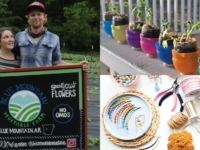“All hail kale!” we cheered with our forks raised before chomping down on bites of kale salad. It was my second class of the day with the fifth graders at Ronan Middle School, who had just finished making three variations of Massaged Kale Salad: Basic, Greek, and Spice it Up. After the salads were ready, the students cleaned up, and then patiently waited while we reviewed the “Don’t Yuck My Yum” Rule, served up our samples, and collectively decided on a cheer. Following the enthusiastic cheer, every 5th grader tried his or her salad—then most of them excitedly sampled the other groups’ concoctions. Such eager tasting by so many 5th graders is a huge success!
To be honest, my first class on the same day had gone a little differently, and it taught me an important lesson. That class had been pretty chaotic and pressed for time; each group had prepared a kale salad and then hastily tasted it on their own. There was no ritual in serving the samples or choosing a cheer and we didn’t get to review “Don’t Yuck My Yum” as a group. Several students who had just spent the entire class preparing the salad didn’t want even want to try it! They staunchly refused. I was surprised by their indifference to their homemade snack—until my experience with the second class.
What I learned in comparing the different reactions of the students from the first to the second class is that when we build in time for ceremony around our food, it makes all the difference.
In many a FoodCorps training, I have learned that creating a positive tasting environment –especially by developing a simple ritual or ceremony around food—is a crucial strategy for encouraging kids to try new foods. While I had heard of “Don’t Yuck My Yum” before, I recently learned specific techniques from other FoodCorps service members that helped me to establish a method for leading taste tests in the classroom. Taking time to set “Don’t Yuck My Yum” (be polite so everyone can enjoy the food) and the “No Thank You Bite” (everyone tries before they decline the food) as class norms is essential. My real new favorite trick, though, is the “Cheers!” The group cheer transforms what used to be an awkward “Okay let’s eat!” to an anticipated and celebratory act we all partake in together.
Conducting tasting activities in the classroom with these strategies has not only been fun—it has been incredibly effective. On a beautiful day at the end of October I had 80 second graders outside “growing” butternut squash vines with their arms and spinning in circles to act out Mission Mountain Food Enterprise Center’s prized squash peeler (see this Valley Journal article for photos and more). Then the teachers and I encouraged the kids to pretend they were haughty kings and queens who politely said “I don’t much care for that” in order to not yuck each other’s yum. After the activity, one of the teachers told me, “Your lesson and positive attitude really made a difference in how [the kids] enjoyed the squash!” And the teacher was right: the classes that had a fun, engaging experience with the squash ended up with WAY fewer leftovers than the other grades that hadn’t danced the squash from the field to their fork.
Lesson learned: Kids will taste and—more often than not—like healthy foods if they’re just given a positive opportunity to try them.






